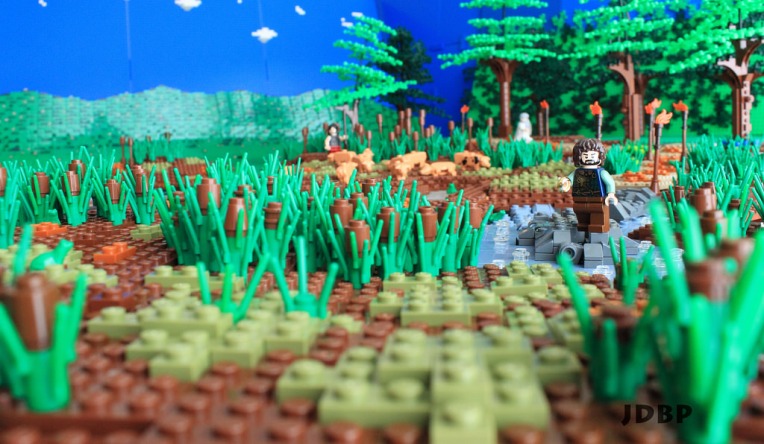From simple puns, mighty web comics spring. That is the premise behind the brilliant new satirical feminist site ‘Manfeels Park‘, a riff on Jane Austen’s ‘Mansfield Park’. Web comics are a crazy popular place for people who want to do modern riffs on history, as my current favourites Hark! A Vagrant and Happletea happily demonstrate. So I thought it was only fitting that I got Manfeels Park creators Morag and Erin to share their love with you.
History Mine: Where did the idea come from?
Morag: It’s Erin’s fault, really. We were chatting about some internet comment thread or other, and I said something sarcastic like, “Aww, you hurt his poor man-feels.” She commented that whenever someone used the word ‘man-feels’, she always mentally thought of the pun Manfeels Park. We immediately decided that this was too good a pun to be allowed to go to waste, and the other ideas – using genuine commentary, using TV stills – that was all borne of laziness really!
HM: What is the particular appeal of Pride and Prejudice?
Mo: Well, it had to be Austen, obviously, or at least recognisably Regency, for the sake of the pun. The more we got into it though the more we realised that Austen was perfect due to the gender politics of the novels. Obviously they’re of their time, but even then Austen had a lot to say about how confined and subjugated women were, how ridiculous it was that they were expected to live their lives waiting and hoping for a good match, that estates were entailed away from the female line, and the unreasonable expectations placed on women in terms of their virtue and chastity while men got to do as they please with comparatively little in the way of punishment or consequence – Austen is, let’s not forget, awash with repeat male offenders like Wickham and Willoughby. Alongside the bounders and cads are the stiff-upper-lipped self-important posh boys with entitlement complexes, most of whom either think they’re God’s gift or at least think they should be. It’s not universal – some are shy, some are older and wiser – but there’s plenty of mockable behaviour from these guys in their less self-aware moments.
On top of Austen’s derision for these bounders and heroes, though, there’s a layer of fondness. Darcy is a total pig for a large chunk of Pride and Prejudice; his proposal scene is utterly cringeworthy in its self-importance and disregard for Lizzy’s feelings, treating it as obvious that she was an unworthy match and perfectly reasonable that he should feel so conflicted – moreover even as he denigrates her family and her connections it’s obvious that he thinks he can abuse them all he likes and Lizzy will accept him regardless.
And of course (SPOILERS!) she doesn’t. But she does grow to love him anyway. She learns that he has a core of decency in spite of his self-importance and entitlement. Maybe I’m reading more in than folk will find in these comics, but I feel like this context – the meta-text I suppose – gives a note of sympathy to the male characters. In ‘Feminism in the Anglosphere‘, the two characters have a short, hostile exchange, and then after a moment’s pause head off toward the house together – they haven’t fallen out. Most of us hardened feminists have dear male friends who frustrate us on a nigh-constant basis with their pig-headedness about issues like privilege, rape culture and representation of women in media, but we love them anyway. I would like to hope that the Austen lovers who read the comic pick up on that dimension – who knows.
As to Pride and Prejudice specifically, to be honest any Austen-y, Regency-era stuff would be fair game in theory as a setting. I’ve thus far been using screencaps from the 1995 BBC Pride & Prejudice specifically for two reasons.
Firstly, it’s an iconic adaptation. The people who love it have often watched it over and over again, and could I’m sure tell you the exact scene used for every comic in the series so far. This gives it extra appeal for those readers because references make our brains happy. Relatedly, using this version I was able to create comics like ‘Lake Scene‘, which exploits the infamous ‘Darcy jumps in a pond because of his man-feels’ beloved by Colin Firth fans everywhere. This scene isn’t actually in the book, but the fans love it anyway. Additionally, I’m not sure any Lizzy Bennet has rolled their eyes heavenward quite as well as the wonderful Jennifer Ehle did!
Secondly, it’s an adaptation I personally know backwards and have thousands of screencaps for. I can scan very quickly to the scene I want to use. Then I pull it into Photoshop, hand trace over it using a graphics tablet, and BOOM, comic drawn. Basically it’s all about laziness again! It takes some skill and patience I suppose but it’s much quicker than drawing from scratch would be and since I have no artistic integrity whatsoever I have no qualms about cutting said corners, particularly when the end result looks pretty good.
HM: Us guys come out with some absolutely bat-shit crazy things when we get typing, how do you pick the nuggets of gold from the mountains of bullshit?
Erin: A lot of trawling through manure, basically. We’ve been engaging with online discussions of feminism for so long that we know all the tried-and-true arguments, so it’s really about looking for relatively short exchanges that sum up the common things that come up. There are a couple of reliable places to go to find guys trotting out these gems, though it’s meant reneging on the ‘no reading the comments’ pledge that I made to keep my blood pressure down. For every MP comic you see assume there are about a dozen more people expressing that same opinion at any given time, just with worse grammar and spelling.
HM: The comedy comes from the juxtaposition of image and text, but how do you match them up?
Mo: Well about half of them are pretty interchangeable – our heroes chatting while dancing, walking on the grounds or what-have-you. In theory I didn’t go into this with any particular plans to customise the image to the text (in fact, I originally intended to do it ‘Dinosaur Comics‘ style and just reuse the same two or three strips over and over with different dialogue and I may yet begin to repeat art). But as I look through the quotes we’ve collected, sometimes scenes from Pride & Prejudice just come to me – the speech in ‘Monster‘ I read and knew it needed to be Darcy’s proposal speech, likewise I saw the quote in ‘Sporting Craze’ and heard Mr Bennet utter it, and the single piece of dialogue in ‘Lake Scene’ just fit perfectly. And as for ‘Handmaiden of the Patriarchy‘, well…
HM: You’ve linked to other comics, such as Hark! A Vagrant. What is the appeal of the medium for you?
Erin: I think I tend to enjoy webcomics because they really require the author to boil down whatever point they’re making into something that fits in five panels (or whatever). Though I love reading books and long-form articles about history and social movements and the like sometimes it’s really refreshing to just get the ultimate highlights, presented in a visually appealing way. Not to mention it’s a lot easier to share (and expect people to read) a comic than something longer, so it allows for connections and propagation in a way that other forms might not.
Mo: To be honest although I do the art for MP, I’m not a huge webcomic reader myself – most of those were chosen by Erin though I’m a massive Kate Beaton (Hark!) fan. We do have a small collection of hard-copy graphic novels and comics but we’re by no means aficionados. I’m a big fan of comics in principle though – when I was a kid my dream job (don’t laugh) was to be an inker – that’s the person who inks over the artist’s sketches before they’re coloured (back in the olden days anyway, increasingly comic book artists don’t divide up the jobs like that any more). I loved tracing and thought that tracing for a living sounded like the best job ever so it’s awesome to get to (sort of) do that now and actually have people see and enjoy it.
Anyway, comics are a great storytelling method, just like novels, or art, or film, and with the amazing comics and graphic novels being produced (over and above the standard fare DC/Marvel stuff – some of which is also very good) they deserve a lot more attention than they get.
I think in the case of Manfeels Park specifically it became a webcomic because of the particular skillset we had available to us to make the joke we wanted to make. It could probably have been done just using the raw screencaps, without converting them into sketches, and had just about the same effect or impact.
HM: In your ‘about’ section, you mention that “Manfeels Park is an exercise in flogging a pun for all it’s worth.” How long could this thing go on for?
Erin: Until we’re truly internet famous and rolling in bitcoins.
Mo: At the moment, judging by the comments on our own website, it’s self-sustaining!
Thanks to Morag and Erin for putting out such a great comic, and thanks for chatting to us about it! If you enjoyed this post, you might also enjoy reading about the other people we have interviewed over the last few months, like the guy who makes historical Lego models, or the people behind Epic Rap Battles of History.





.jpg)








